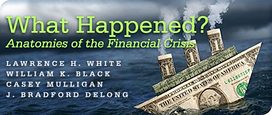Professor White showed that one-year real interest rates were low during the housing boom. That’s a good starting point because, if the Fed can affect anything real, it is the short-term interest rate. Now let’s use that information to demonstrate that the impact on housing prices is minimal.
Since I will demonstrate that the housing-price impact is small, I will assume that the supply of housing is fixed; an elastic supply of housing would only reduce the price impact below what I calculate here.
Each house in place today produces services for a number of years. To a good approximation, we can assume that each house lasts forever, except that it depreciates exponentially (but slowly). The market value of the house is the present value of those services. Low interest rates can raise housing prices (although not much), because future services are discounted less.
Suppose that annual real interest rates were going to be one percentage point (100 basis points) lower for a year. Then the cost of buying a house, holding it for a year, and then selling it would be essentially one percent less. The low one-year interest rate would not affect the selling price at the end of the year because, by assumption, the reduction lasted only for a year and the next buyer will be back to normal interest rates. So the source of benefit from the low rate is that the initial buyer reduces the carrying cost for a year.
A 100-basis-point-lower interest rate for one year would justify paying about $202,000 for a house that would ultimately be worth $200,000. A 100-basis-point-lower interest rate for two years would raise purchase prices by about two percent. (Actually, it would be less, because of the discounting of the second year, not to mention the supply response.) A 200-basis-point reduction for two years would raise purchase prices by less than four percent, etc.
Thus, interest-rate reductions for a short horizon do raise housing prices, but not much by the standards of this recent housing boom when housing prices were tens of percentage points higher (according to Case-Shiller, practically 100 percent higher). A house that would ultimately be worth $200,000 was actually selling for something in the neighborhood of $300,000.
Perhaps Professor White would argue that market participants expected short term interest rates to remain low for much longer than a couple of years. If so, he is on shaky ground. First, such a claim is at odds with long-term interest-rate data. As I indicated in my article, long-term mortgage rates were not low during the housing boom. It’s not hard to find commentary from those years recognizing the low short-term rates were not expected to last.
Second, such a claim gets closer to my hypothesis: that it was optimism that raised housing prices, not much of anything tangible during the boom. Whether it was optimism about future interest rates, future tastes, or future technology is more of a quibble.

